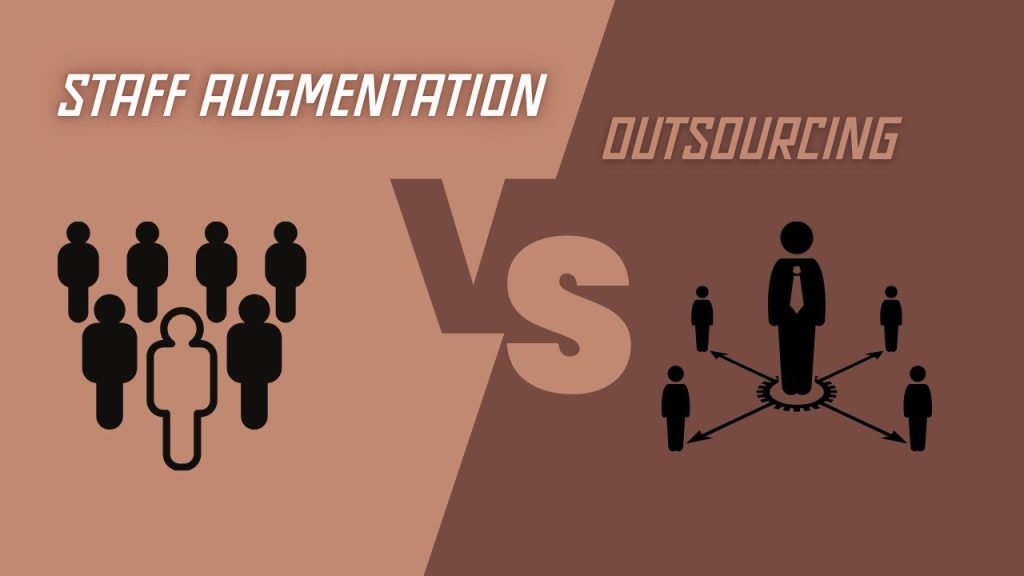The staff augmentation model is an excellent approach to fill the team’s capacity when you require extra experienced hands when working on a software project. The global IT staff augmentation service is anticipated to grow between 2023 and 2028. The emergence of staff augmentation is being led by teams that are trying to strike a balance between productivity and profitability. If you need experts to make up for the temporary shortcomings in your team or work, you will have to understand more about the staff augmentation model. In this guide, we will explain:
What is Staff Augmentation?
Hiring additional employees for a temporary task or a short-term scarcity can be costly and time-consuming, which is why you should hire augmented staff that will get you the workforce right and only when you need them. To better understand the idea, here is a staff augmentation example, a growing e-commerce company is experiencing significant success and needs to develop a mobile app to cater to its increasing customer base. However, their in-house development team lacks specific expertise in mobile app development, particularly in building for a specific platform (e.g., iOS).
The solution? The company decides to leverage staff augmentation. They partner with a staffing agency specializing in technology professionals and request the addition of two experienced iOS app developers to their team.
Staff augmentation is a flexible staffing strategy where businesses temporarily hire additional personnel to supplement their existing workforce. These hired individuals, often referred to as augmented staff, possess specific skills and expertise needed for specific projects or to address temporary capacity gaps.
The best thing about this approach is that this augmented staff becomes an extended part of the team but they are not particularly regular employees. They are only tapped and paid when the need arises. Ending their partnership is also easy because they are aware that their work depends on a per-project or per-engagement basis.
How does staff augmentation work?
Staff augmentation is a cooperation model where a company expands its in-house staff by temporarily hiring several outsourcing IT specialists. But how does it exactly work?
Let’s imagine a marketing agency called XO that excels in social media campaigns but needs a website revamp. XO wants to update its website with a fresh design and improved user experience. However, their in-house team excels in social media but lacks expertise in web development.
XO decides to partner with a company that provides staff augmentation services. They outline their website goals and the specific skills needed, such as experience with a website development platform like WordPress and proficiency in user interface(UI) design. The staff augmentation company takes care of the nitty-gritty part of finding the right candidates for you so you will immediately have CVs of qualified web developers that XO can choose from. They facilitate the introduction and discuss project details, ensuring a good fit.
The web developer starts working remotely or joins XO’s office as an augmented member. They collaborate closely with the existing marketing team, understanding their vision for the website and receiving guidance on the brand identity.
The staff augmentation company often provides project management support, ensuring clear communication, deadlines are met, and any challenges are addressed efficiently. With the augmented staff’s expertise, XO launches a modern and user-friendly website, enhancing their online presence and attracting new clients.
Types of Staff Augmentation
Before delving into the various categories of staff augmentation, it’s essential to understand the diverse landscape of talent acquisition methods and platforms available in today’s market. Staff augmentation categories include:
- Traditional Staff Providers: These providers offer temporary laborers for short-term projects.
- Master Vendor Staff Providers: A single vendor manages the entire staffing program, ensuring seamless coordination.
- Specialized/Boutique Agencies: Small firms specializing in highly-specific talent pools, offering niche expertise.
- Gig Platforms: Online platforms providing on-demand access to independent workers for flexible engagements.
- On-demand Talent Platforms: Platforms offering access to highly-skilled specialists for specific project needs.
- Independent Contractors: Directly engaged by organizations, these contractors offer specialized services tailored to project requirements.
When to use staff augmentation
Increasing your headcount should be a carefully curated decision. It is important to fully determine when exactly you need it. So here are three reasons to know when to augment your team.
To strengthen your in-house team
It is important to complement or strengthen your current expertise when releasing a new product or starting a new project, even if you do have an in-house team. In that case, augmenting your IT team would be a great idea.
To meet a specific deadline
Hiring is a long and tiring process. From job posting to onboarding, it takes an average of two months, to get someone right for the job. You probably don’t have the time and patience to go through this long haul which is why you need staff augmentation. It is an effective way to increase IT staff and meet your needs regardless of the length of your contract. This is also a great opportunity as it provides instant access to a global pool of software developers enabling companies to augment from around the world.
Decreased Project Costs
In the staff augmentation model, the service provider provides training, office spaces, and workstations, thus covering management and administrative costs. You will only be paying a fixed amount based on how many staff you need for the project.
How to choose the right model
To choose the right model, you need to strategically analyze which the right model is for you. You can avoid a lot of unnecessary delays by choosing the right model that aligns with your workflow.
First, identify your needs. Try and understand the end goal and what exactly you are expecting from the staff augmentation resources you will be working with. Evaluate the amount of time you would be dedicated to managing external team members and also understand the skill gaps you are aiming to cover given the capabilities of your in-house team.
Evaluate your candidates before choosing them to avoid delays and complications. To make sure you are on the same page and ensure the candidate can help with the project, begin with a pilot task. Cultural differences can also become a major source of hidden costs when miscommunication happens especially when you are working with offshore external team members.
Benefits of staff augmentation
Here are 6 key benefits of staff augmentation for businesses:
Access to Specialized Skills: Gain immediate access to skilled professionals with the specific expertise needed for specific projects or tasks, addressing skill gaps within the existing team.
- Increased Flexibility and Scalability: Easily scale your workforce up or down based on project demands without the long-term commitment of full-time hires. This allows for greater agility and adaptability to changing business needs.
- Cost-Effectiveness: Pay only for the time and expertise required, reducing recruitment, training, and overhead costs associated with hiring full-time employees. This can be particularly beneficial for short-term projects or temporary workload increases.
- Faster Time-to-Completion: Expedite project completion by adding experienced professionals who can hit the ground running and contribute immediately, reducing overall project timelines.
- Reduced Risk and Burden on Existing Team: Mitigate the risk of hiring full-time employees who may not be a good fit and avoid overloading existing team members with additional tasks beyond their capacity.
- Improved Project Management: Leverage the expertise of staff augmentation companies who often provide project management support, ensuring clear communication, efficient resource allocation, and adherence to deadlines.
By leveraging staff augmentation, businesses can gain a competitive edge by accessing specialized skills, optimizing resource allocation, and achieving their goals efficiently and cost-effectively.
Difference between staff augmentation and outsourcing

Both staff augmentation and outsourcing are methods for acquiring additional resources to complete tasks or projects, but they differ in several key aspects:
Control and Management:
Staff Augmentation: The client company retains control over project management and directly manages the augmented staff, often integrating them into their existing team.
Outsourcing: The outsourcing company manages the project and team, delivering a specific outcome based on agreed-upon goals and deadlines.
Level of Integration:
Staff Augmentation: Augmented staff work closely with the existing team, fostering collaboration and knowledge transfer. They often work on-site or remotely as integrated team members.
Outsourcing: The outsourced team typically works independently from the client company, with less direct interaction except for progress updates and approvals.
Expertise and Focus:
Staff Augmentation: Focuses on filling specific skill gaps within the existing team. Augmented staff may possess broader expertise but are primarily brought in for their targeted skills relevant to the project.
Outsourcing: Often involves entire teams with specialized expertise in a particular area, such as software development or customer service. The outsourced team handles the entire project or process.
Cost and Flexibility:
Staff Augmentation: This can be more expensive than outsourcing due to the overhead costs associated with managing the augmented staff. However, it offers greater flexibility in terms of scaling the team up or down as needed.
Outsourcing: This can be more cost-effective as the outsourcing company is responsible for managing the team and associated costs. However, it generally offers less flexibility in scaling the team or adapting to changing project needs.
Ultimately, the best choice between staff augmentation and outsourcing depends on your specific needs and priorities. Consider factors like the level of control required, project complexity, desired expertise, budget constraints, and desired level of team integration when making your decision.
In conclusion, Staff augmentation offers businesses unparalleled flexibility, scalability, and access to specialized skills, making it a valuable strategy for meeting project demands efficiently and cost-effectively. By understanding its nuances and best practices, organizations can harness its power to drive growth and success in today’s dynamic business landscape.


